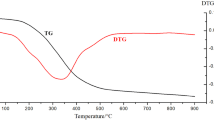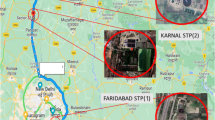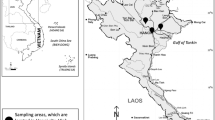Abstract
This study aimed at investigating the influence of anaerobic digestion (AD) on the humification of sludge–leachate matrix and the risk of heavy metals (HMs). The characteristics of humic acid (HA) and HM in different digestate (D1–D4) were examined after AD of sewage sludge (SS) with fresh leachate (FL) at varying ratios (i.e., 0, 5%, 15%, 30%). The results showed that C and O constituted the major elements of HA, with the content of 51.73–52.35% and 28.34–28.73%, respectively. Further analysis of the ultraviolet–visible and Fourier transform infrared spectra indicated that AD of co-substrates containing 5% and 15% of FL presented increased humification degree compared to the mono-digestion, whereas co-digestion with 30% of FL showed the opposite results. Moreover, the HM risk assessment suggested that co-digestion decreased the risk level of Cr, Cu, Zn, and Mn in D2 and D3 but increased that of Cr, Ni, Cu, and Mn in D4. From these findings, AD of SS with FL at relatively low proportions (i.e., 5%, 15%) was conducive to enhancing the humification degree and reducing the HM risk.




Similar content being viewed by others
References
Albrecht R, Petit JL, Terrom G, Périssol C (2011) Comparison between UV spectroscopy and nirs to assess humification process during sewage sludge and green wastes co-composting. Bioresour Technol 102:4495–4500
Appels L, Baeyens J, Degrève J, Dewil R (2008) Principles and potential of the anaerobic digestion of waste-activated sludge. Prog Energy Combust Sci 34:755–781
Berenjkar P, Islam M, Yuan Q (2019) Co-treatment of sewage sludge and mature landfill leachate by anaerobic digestion. Int J Environ Sci Technol 16:2465–2474
Braga AFM, Zaiat M, Silva GHR, Fermoso FG (2017) Metal fractionation in sludge from sewage UASB treatment. J Environ Manag 193:98–107
Chen Y, Senesi N, Schnitzer M (1977) Information provided on humic substances by E4/E6 ratios. Soil Sci Soc Am J 41:352–358
Crini G, Lichtfouse E (2019) Advantages and disadvantages of techniques used for wastewater treatment. Environ Chem Lett 17:145–155
Dong B, Liu XG, Dai LL, Dai XH (2013) Changes of heavy metal speciation during high-solid anaerobic digestion of sewage sludge. Bioresour Technol 131:152–158
Hu J, Wu JG, Qu XJ, Li JM (2018) Effects of organic wastes on structural characterizations of humic acid in semiarid soil under plastic mulched drip irrigation. Chemosphere 200:313–321
Jaafari J, Yaghmaeian K (2019) Response surface methodological approach for optimizing heavy metal biosorption by the blue-green alga Chroococcus disperses. Desalin Water Treat 142:225–234
Legros S, Levard C, Marcato-Romain CE, Guiresse M, Doelsch E (2017) Anaerobic digestion alters copper and zinc speciation. Environ Sci Technol 51:10326–10334
Li XW, Dai XH, Dai LL, Liu ZG (2015) Two-dimensional FTIR correlation spectroscopy reveals chemical changes in dissolved organic matter during the biodrying process of raw sludge and anaerobically digested sludge. RSC Adv 5:82087–82096
Li H, Li YK, Li CC (2017) Evolution of humic substances during anaerobic sludge digestion. Environ Eng Manag J 15:1577–1582
Li JH, Zhang M, Ye ZY, Yang CM (2019) Effect of manganese oxide-modified biochar addition on methane production and heavy metal speciation during the anaerobic digestion of sewage sludge. J Environ Sci 76:267–277
Li JX, Wang LA, Wang L, Zhan XY, Huang C (2021) Exploring the biogas production and microbial community from co-digestion of sewage sludge with municipal solid waste incineration fresh leachate. Int J Environ Sci Technol 18:901–912
Lin CY, Chen CC (1999) Effect of heavy metals on the methanogenic UASB granule. Water Res 33:409–416
Majumdar SS, Das SK, Saha T, Panda GC, Bandyopadhyoy T, Guhab AK (2008) Adsorption behavior of copper ions on Mucor rouxii biomass through microscopic and FTIR analysis. Colloids Surf B Biointerfaces 63:138–145
Merlo C, Vázquez C, Iriarte AG, Romero CM (2020) Chemical and spectroscopic characterization of humic substances from sediment and riparian soil of a highly polluted urban river (Suquía River, Córdoba, Argentina). Int J Sediment Res 35:287–294
Naghipour D, Jaafari J, Ashrafi SD, Mahvi AH (2017) Remediation of heavy metals contaminated silty clay loam soil by column extraction with ethylenediaminetetraacetic acid and nitrilo triacetic acid. J Environ Eng 143:04017026
Naghipour D, Taghavi K, Ashournia M, Jaafari J, Movarrekh RA (2020) A study of Cr(VI) and NH4+ adsorption using greensand (glauconite) as a low-cost adsorbent from aqueous solutions. Water Environ J 34:45–56
Nkoa R (2014) Agricultural benefits and environmental risks of soil fertilization with anaerobic digestates: a review. Agron Sustain Dev 34:473–492
Peng H, Zhang YB, Tan DM, Zhao ZQ, Zhao HM, Quan X (2018) Roles of magnetite and granular activated carbon in improvement of anaerobic sludge digestion. Bioresour Technol 249:666–672
Réveillé V, Mansuy L, Jardé É, Garnier-Sillama É (2003) Characterisation of sewage sludge-derived organic matter: lipids and humic acids. Org Geochem 34:615–627
Rodríguez FJ, Schlenger P, García-Valverde M (2016) Monitoring changes in the structure and properties of humic substances following ozonation using UV–Vis, FTIR and 1H NMR techniques. Sci Total Environ 541:623–637
Seyedsalehi M, Jaafari J, Hélix-Nielsen C, Hodaifa G, Manshouri M, Ghadimi S, Hafizi H, Barzanouni H (2018) Evaluation of moving-bed biofilm sequencing batch reactor (MBSBR) in operating A2O process with emphasis on biological removal of nutrients existing in wastewater. Int J Environ Sci Technol 15:199–206
Shao LM, Wang TF, Li TS, Lü F, He PJ (2013) Comparison of sludge digestion under aerobic and anaerobic conditions with a focus on the degradation of proteins at mesophilic temperature. Bioresour Technol 140:131–137
Siddique MNI, Wahid ZB (2018) Enhanced methane yield by codigestion of sewage sludge with microalgae and catering waste leachate. Water Environ Res 90:835–839
Singh KP, Mohan D, Singh VK, Malik A (2005) Studies on distribution and fractionation of heavy metals in Gomti river sediments—a tributary of the Ganges, India. J Hydrol 312:14–17
Song CH, Li MX, Xi BD, Wei ZM, Zhao Y, Jia X (2015) Characterisation of dissolved organic matter extracted from the bio-oxidative phase of co-composting of biogas residues and livestock manure using spectroscopic techniques. Int Biodeter Biodegr 103:38–50
Tang YF, Li XW, Dong B, Huang JJ, Wei YH, Dai XH, Dai LL (2018) Effect of aromatic repolymerization of humic acid-like fraction on digestate phytotoxicity reduction during high-solid anaerobic digestion for stabilization treatment of sewage sludge. Water Res 143:436–444
Tessier A, Campbell PG, Bisson M (1979) Sequential extraction procedure for the speciation of particulate trace metals. Anal Chem 51:844–851
Wu D, Li L, Zhao XF, Peng Y, Yang PJ, Peng XY (2019) Anaerobic digestion: a review on process monitoring. Renew Sustain Energy Rev 103:1–12
Xue S, Zhao QL, Wei LL, Ren NQ (2009) Behavior and characteristics of dissolved organic matter during column studies of soil aquifer treatment. Water Res 43:499–507
Zbytniewski R, Buszewski B (2005) Characterization of natural organic matter (NOM) derived from sewage sludge compost. Part 1: chemical and spectroscopic properties. Bioresour Technol 96:471–478
Zhan XY, Wang LA, Wang L, Wang X, Gong J, Yang L, Bai JS (2019) Enhanced geopolymeric co-disposal efficiency of heavy metals from MSWI fly ash and electrolytic manganese residue using complex alkaline and calcining pre-treatment. Waste Manag 98:135–143
Zhang WL, Zhang L, Li AM (2015) Anaerobic co-digestion of food waste with MSW incineration plant fresh leachate: process performance and synergistic effects. Chem Eng J 259:795–805
Zhu NM, Li Q, Guo XJ, Zhang H, Deng Y (2014) Sequential extraction of anaerobic digestate sludge for the determination of partitioning of heavy metals. Ecotox Environ Saf 102:18–24
Acknowledgements
This work was supported by the Science and Technology Project of Chongqing, China (cstc2016shmszx90004), the National Key Research and Development Project of China (2019YFC1906104), and the Fundamental Research Funds for the Central Universities (2020CDCGHJ014).
Author information
Authors and Affiliations
Corresponding author
Ethics declarations
Conflict of interest
The authors declare no conflict of interest.
Additional information
Editorial responsibility: Samareh Mirkia.
Rights and permissions
About this article
Cite this article
Li, J.X., Wang, L.A., Zhan, X.Y. et al. Investigating the humification degree and heavy metal risk as influenced by anaerobic co-digestion of sewage sludge with fresh leachate. Int. J. Environ. Sci. Technol. 19, 12385–12394 (2022). https://doi.org/10.1007/s13762-022-03984-5
Received:
Revised:
Accepted:
Published:
Issue Date:
DOI: https://doi.org/10.1007/s13762-022-03984-5




